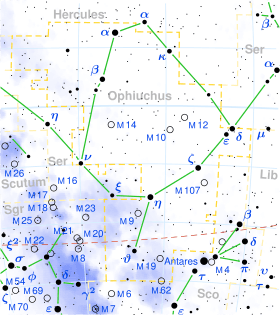Psi Ophiuchi
Psi Ophiuchi, which is Latinized from ψ Ophiuchi, is a single[9] star in the equatorial constellation of Ophiuchus, located next to the western constellation border with Scorpius. It has an orange hue and is visible to the naked eye as a faint point of light with an apparent visual magnitude of 4.50.[2] The distance to this object is approximately 199 light years based on parallax.[1]
| Observation data Epoch J2000 Equinox J2000 | |
|---|---|
| Constellation | Ophiuchus |
| Right ascension | 16h 24m 06.18464s[1] |
| Declination | −20° 02′ 14.3784″[1] |
| Apparent magnitude (V) | 4.50[2] |
| Characteristics | |
| Evolutionary stage | horizontal branch[3] |
| Spectral type | K0- II-III[4] |
| U−B color index | +0.84[2] |
| B−V color index | +1.03[2] |
| Astrometry | |
| Radial velocity (Rv) | +0.60[5] km/s |
| Proper motion (μ) | RA: −20.29[1] mas/yr Dec.: −47.65[1] mas/yr |
| Parallax (π) | 16.35 ± 0.25[1] mas |
| Distance | 199 ± 3 ly (61.2 ± 0.9 pc) |
| Absolute magnitude (MV) | 0.806[3] |
| Details[6] | |
| Mass | 1.61 M☉ |
| Radius | 11.45 R☉ |
| Luminosity | 65.9 L☉ |
| Surface gravity (log g) | 2.56 cgs |
| Temperature | 4,864 K |
| Metallicity [Fe/H] | −0.20 dex |
| Rotational velocity (v sin i) | < 1.0[7] km/s |
| Other designations | |
| Database references | |
| SIMBAD | data |
This is an aging giant or bright giant star with a stellar classification of K0- II-III,[4] which indicates it has exhausted the supply of hydrogen at its core then cooled and expanded. At present it has 11 times the girth of the Sun, while having 1.6 times the Sun's mass.[6] It is a red clump giant, meaning it is on the horizontal branch and is generating energy through core helium fusion.[3] The star is radiating 66 times the luminosity of the Sun from its swollen photosphere at an effective temperature of 4,864 K.[6]
References
- Van Leeuwen, F. (2007). "Validation of the new Hipparcos reduction". Astronomy and Astrophysics. 474 (2): 653. arXiv:0708.1752. Bibcode:2007A&A...474..653V. doi:10.1051/0004-6361:20078357. Vizier catalog entry
- Ducati, J. R. (2002). "VizieR Online Data Catalog: Catalogue of Stellar Photometry in Johnson's 11-color system". CDS/ADC Collection of Electronic Catalogues. 2237. Bibcode:2002yCat.2237....0D.
- Liu, Y. J.; et al. (2007). "The abundances of nearby red clump giants". Monthly Notices of the Royal Astronomical Society. 382 (2): 553. Bibcode:2007MNRAS.382..553L. doi:10.1111/j.1365-2966.2007.11852.x.
- Keenan, Philip C.; McNeil, Raymond C. (1989). "The Perkins catalog of revised MK types for the cooler stars". Astrophysical Journal Supplement Series. 71: 245. Bibcode:1989ApJS...71..245K. doi:10.1086/191373.
- Gontcharov, G. A. (2006). "Pulkovo Compilation of Radial Velocities for 35 495 Hipparcos stars in a common system". Astronomy Letters. 32 (11): 759. arXiv:1606.08053. Bibcode:2006AstL...32..759G. doi:10.1134/S1063773706110065.
- Reffert, Sabine; et al. (2015). "Precise radial velocities of giant stars". Astronomy & Astrophysics. 574: A116. arXiv:1412.4634. Bibcode:2015A&A...574A.116R. doi:10.1051/0004-6361/201322360. hdl:10722/215277. Vizier catalog entry
- De Medeiros, J. R.; Alves, S.; Udry, S.; Andersen, J.; Nordström, B.; Mayor, M. (2014). "A catalog of rotational and radial velocities for evolved stars". Astronomy & Astrophysics. 561: A126. arXiv:1312.3474. Bibcode:2014A&A...561A.126D. doi:10.1051/0004-6361/201220762. Vizier catalog entry
- "psi Oph". SIMBAD. Centre de données astronomiques de Strasbourg. Retrieved 2019-10-26.
- Eggleton, P. P.; Tokovinin, A. A. (September 2008). "A catalogue of multiplicity among bright stellar systems". Monthly Notices of the Royal Astronomical Society. 389 (2): 869–879. arXiv:0806.2878. Bibcode:2008MNRAS.389..869E. doi:10.1111/j.1365-2966.2008.13596.x.
